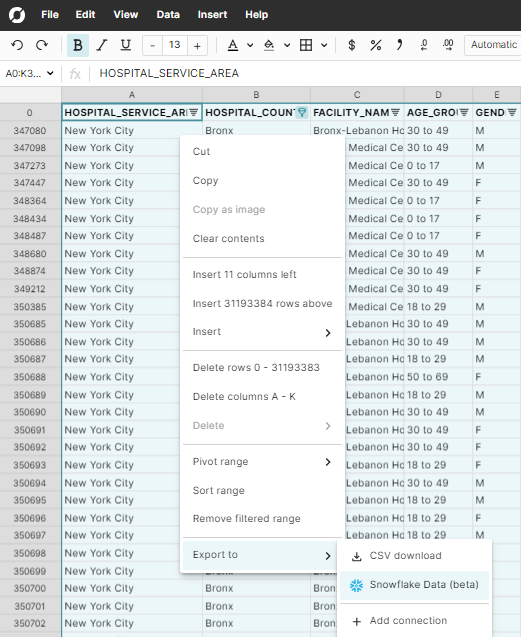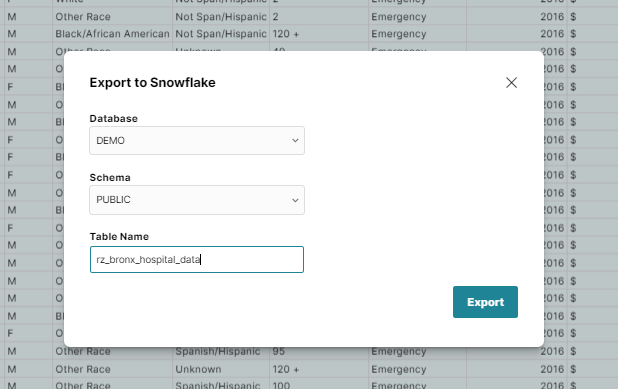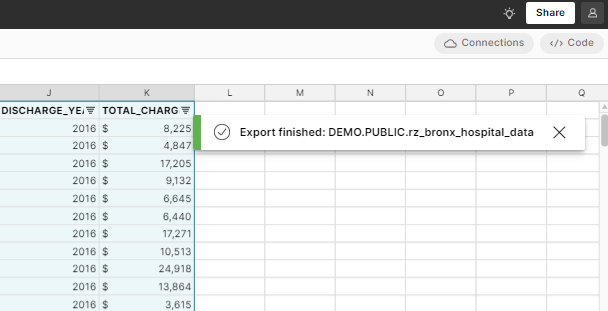Loading data into Snowflake is no longer a task reserved for data teams who know SQL. When connected to a Snowflake account, Row Zero spreadsheet users can now select a data set and export it to Snowflake. Row Zero will create a new table in Snowflake with a specified name and load all data from Row Zero into the Snowflake table. Once the table is created, it can be accessed by any application connected to Snowflake. This feature enables business users to maintain common sources of truth for data sets that would otherwise be stored on locally hosted spreadsheets.
- Instructions to import data from a Row Zero spreadsheet into Snowflake
- Why is it hard to export data from a spreadheet into Snowflake?
- What is Snowflake?
- What is Row Zero
- What are the benefits of using Row Zero with Snowflake?
Instructions to import data from a Row Zero spreadsheet into Snowflake
With a connected Snowflake account, you can export data sets from Row Zero to your cloud data warehouse. Once you've defined the data you would like to save to Snowflake, right click on the data table or selected range and navigate to 'Export > Snowflake Data' in the context menu.

The export to Snowflake modal will pop and ask you to select the database, schema, and specify a table name. New table names are forced to start with 'rz_' to avoid overwriting any tables already in the Snowflake cloud data warehouse. Hit export and Row Zero will create the new table in Snowflake and import all the data. When the export is complete, you will see a notification in the upper right-hand corner.


To verify your table is in Snowflake, you can use either of the commands below.
show tables
select * from rz_tablename
Why is it hard to export data from a spreadsheet into Snowflake
Data is generally loaded into Snowflake through automated pipelines built by data teams. Snowflake supports CSV uploads through the web portal but there are limits to the size of files that can be uploaded. Without using the upload feature, Snowflake users must write SQL to import data from other cloud repositories. These upload pathways are generally inaccessible to business users who do the majority of their analysis in spreadsheets. Spreadsheets also act as data storage mechanisms as business teams use them as a source of record for processes managed outside a company's data stack. In order for a company to consolidate all data into Snowflake and maintain a source of truth that's referenceable by other business teams and access is monitored, locally maintained spreadsheets need to be saved to Snowflake.
Row Zero is a spreadsheet that runs in the cloud, opens billion row data sets, and connects directly to snowflake. Row Zero's connectivity and performance make it easy for business teams to import data sets from Snowflake, analyze, and with a couple clicks, save those data sets to Snowflake. Row Zero's capability brings spreadsheet work into the company's unified data stack and prevents locally stored spreadsheets from being out of date or creating security risks. Data governance strategies typically see spreadsheets as a risk but with Row Zero's import and export from Snowflake spreadsheets support data governance initiatives.
What is Snowflake?
Snowflake Computing is a cloud data warehouse that simplifies data storage and analysis. Unlike traditional data warehousing solutions, Snowflake operates on a cloud-native architecture, enabling organizations to seamlessly store, manage, and analyze vast amounts of data across multiple clouds without the constraints of hardware limitations. Snowflake utilizes a structured data storage model known as a "data lakehouse," which combines the benefits of data warehousing and data lakes. This architecture allows for separation of storage and compute, providing elasticity and scalability.
What is Row Zero?
Row Zero is a last mile analytics tool for finance, operations, marketing, and other business teams that enables them to work with large data sets in a familiar spreadsheet interface. Row Zero runs in the cloud, can open billion row data sets, connect directly to data repositories, export data to data warehouses, and supports role-based sharing.
What are the benefits of using Row Zero with Snowflake?
A Snowflake cloud data warehouse is the foundation of a company's data stack. Data teams build pipelines to store data in Snowflake and connect BI tools to build dashboards for monitoring key metrics. While this setup supports 2/3rds of the analytics needs within a business, the last 1/3rd also known as the last mile of analytics is still underserved. The last mile of analytics is all the work completed by business teams in spreadsheets. Accounting, finance, operations, marketing and other business teams use a spreadsheet as their primary data analysis tool and are generally not interacting with a company's Snowflake cloud data warehouse. The last mile of analytics lives outside the data warehouse, is untraceable, and is often done with static exports from databases. Analyses done in spreadsheets pose data governance risks and are stale as soon as they are complete. With Row Zero, business teams who need a spreadsheet can connect directly to live data sets stored in Snowflake, can save their data sets to the data warehouse, and keep data in the cloud so access can be tracked and monitored. To enable your business team to begin interacting with Snowflake, open a Row Zero workbook and connect your Snowflake instance today.